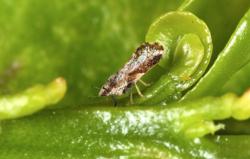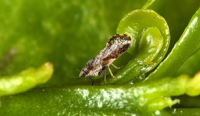Threat of the bacterial disease huanglongbing for citrus
The Asian citrus psyllid (ACP),
Diaphorina citri, and the devastating bacterium
Candidatus liberibacter asiaticus (
Clas) that it vectors that causes huanglongbing (HLB) disease, have become established in most of the citrus producing regions of the United States. Currently there is no cure for the disease and growers are treating repeatedly with insecticides to reduce ACP populations in the hopes of slowing the spread of the disease. A wide range of regionally funded and federally funded (NIFA) research programs are underway to provide both mid-term and long-term solutions to the HLB problem. These include both genetically engineered as well as non-genetically engineered tactics. The non-genetically engineered tactics include a wide range of activities to detect HLB early in the infection cycle so that infected trees can be rogued out of the orchard, traditional breeding for rootstock or scion resistance, tactics to reduce psyllid populations (attract and kill trapping, biological control, and rNA interference to prevent transmission to name a few). Genetically engineered projects may focus on altering the plant inserting an HLB resistant spinach gene into citrus. Or GE projects may focus on the psyllid. The ‘Nupsyllid’ program is looking at 3 approaches to creating a psyllid that can not effectively transmit the disease and this nupsyllid would be released, interbreed with wild psyllids and reduce HLB spread. The hope is that one or a combination of these tactics will control the disease and protect the citrus industries.
Other pests and diseases have the potential to affect citrus and this web site will highlight these as they become significant issues.
Learn about tools being developed to protect citrus against HLB
This is your resource for finding out about existing and new tools being developed by researchers to protect citrus from damage from the causative agent of
huanglongbing (HLB),
Candidatus Liberibacter asiaticus (
CLas).
Technologies developed to fight HLB
Every year diverse ecosystems throughout the United States are invaded by new, often-destructive exotic pests, resulting in annual economic losses in the billions.
Researchers around the nation are collaborating to find ways to alter the psyllid or the plant to fight the currently incurable HLB disease that has devastated Florida citrus and is threatening California, Texas and Arizona citrus.
Altering the psyllid: Approaches to altering the psyllid include infecting psyllids with Wohlbachia or viruses that reduce their ability to reproduce or their ability to transmit the Clas bacterium and also directly transforming the genes of the psyllid.
Altering the plant: Numerous laboratories are conducting traditional breeding programs and genetic engineering of citrus to create HLB-resistant plants.
It is likely that more than one approach will be needed to fully control this disease. Details about this work, along with other advances in citrus research, can be seen by visiting our Research Snapshots pages.


